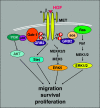Mechanisms of HGF/Met signaling to Brk and Sam68 in breast cancer progression
- PMID: 22124844
- PMCID: PMC3971994
- DOI: 10.1007/s12672-011-0097-z
Mechanisms of HGF/Met signaling to Brk and Sam68 in breast cancer progression
Abstract
Signal transduction pathways downstream of receptor tyrosine kinases (RTKs) are often deregulated during oncogenesis, tumor progression, and metastasis. In particular, the peptide growth factor hormone, hepatocyte growth factor (HGF), and its specific receptor, Met tyrosine kinase, regulate cancer cell migration, thereby conferring an aggressive phenotype (Nakamura et al., J Clin Invest 106(12):1511-1519, 2000; Huh et al., Proc Natl Acad Sci U S A 101:4477-4482, 2004). Additionally, overexpression of Met is associated with enhanced invasiveness of breast cancer cells (Edakuni et al., Pathol Int 51(3):172-178, 2001; Jin et al., Cancer 79(4):749-760, 1997; Tuck et al., Am J Pathol 148(1):225-232, 1996). Here, we review the regulation of recently identified novel downstream mediators of HGF/Met signaling, Breast tumor kinase (Brk/PTK6), and Src-associated substrate during mitosis of 68 kDa (Sam68), and discuss their relevance to mechanisms of breast cancer progression.
Figures





Similar articles
-
Breast tumor kinase and extracellular signal-regulated kinase 5 mediate Met receptor signaling to cell migration in breast cancer cells.Breast Cancer Res. 2010;12(4):R60. doi: 10.1186/bcr2622. Epub 2010 Aug 5. Breast Cancer Res. 2010. PMID: 20687930 Free PMC article.
-
Tyrosine phosphorylation of sam68 by breast tumor kinase regulates intranuclear localization and cell cycle progression.J Biol Chem. 2005 Nov 18;280(46):38639-47. doi: 10.1074/jbc.M505802200. Epub 2005 Sep 22. J Biol Chem. 2005. PMID: 16179349
-
Met receptors induce Sam68-dependent cell migration by activation of alternate extracellular signal-regulated kinase family members.J Biol Chem. 2011 Jun 17;286(24):21062-72. doi: 10.1074/jbc.M110.211409. Epub 2011 Apr 13. J Biol Chem. 2011. PMID: 21489997 Free PMC article.
-
Brk/PTK6 signaling in normal and cancer cell models.Curr Opin Pharmacol. 2010 Dec;10(6):662-9. doi: 10.1016/j.coph.2010.08.007. Epub 2010 Sep 9. Curr Opin Pharmacol. 2010. PMID: 20832360 Free PMC article. Review.
-
The role of hepatocyte growth factor (scatter factor) in epithelial-mesenchymal transition and breast cancer.Can J Physiol Pharmacol. 2002 Feb;80(2):91-102. doi: 10.1139/y02-010. Can J Physiol Pharmacol. 2002. PMID: 11934261 Review.
Cited by
-
Sam68 is a druggable vulnerability point in cancer stem cells.Cancer Metastasis Rev. 2024 Mar;43(1):441-456. doi: 10.1007/s10555-023-10145-8. Epub 2023 Oct 4. Cancer Metastasis Rev. 2024. PMID: 37792222 Free PMC article. Review.
-
Role of Sam68 in post-transcriptional gene regulation.Int J Mol Sci. 2013 Nov 28;14(12):23402-19. doi: 10.3390/ijms141223402. Int J Mol Sci. 2013. PMID: 24287914 Free PMC article. Review.
-
Cancer-Associated Mutations in Breast Tumor Kinase/PTK6 Differentially Affect Enzyme Activity and Substrate Recognition.Biochemistry. 2015 May 26;54(20):3173-82. doi: 10.1021/acs.biochem.5b00303. Epub 2015 May 13. Biochemistry. 2015. PMID: 25940761 Free PMC article.
-
Pathways driving the endocytosis of mutant and wild-type EGFR in cancer.Oncoscience. 2014 Jul 29;1(8):504-12. doi: 10.18632/oncoscience.67. eCollection 2014. Oncoscience. 2014. PMID: 25594057 Free PMC article.
-
A Novel Six Autophagy-Related Genes Signature Associated With Outcomes and Immune Microenvironment in Lower-Grade Glioma.Front Genet. 2021 Oct 13;12:698284. doi: 10.3389/fgene.2021.698284. eCollection 2021. Front Genet. 2021. PMID: 34721517 Free PMC article.
References
-
- Edakuni G, et al. Expression of the hepatocyte growth factor/c-Met pathway is increased at the cancer front in breast carcinoma. Pathol Int. 2001;51(3):172–178. - PubMed
-
- Jin L, et al. Expression of scatter factor and c-met receptor in benign and malignant breast tissue. Cancer. 1997;79(4):749–760. - PubMed
Publication types
MeSH terms
Substances
Grants and funding
LinkOut - more resources
Full Text Sources
Medical
Miscellaneous

